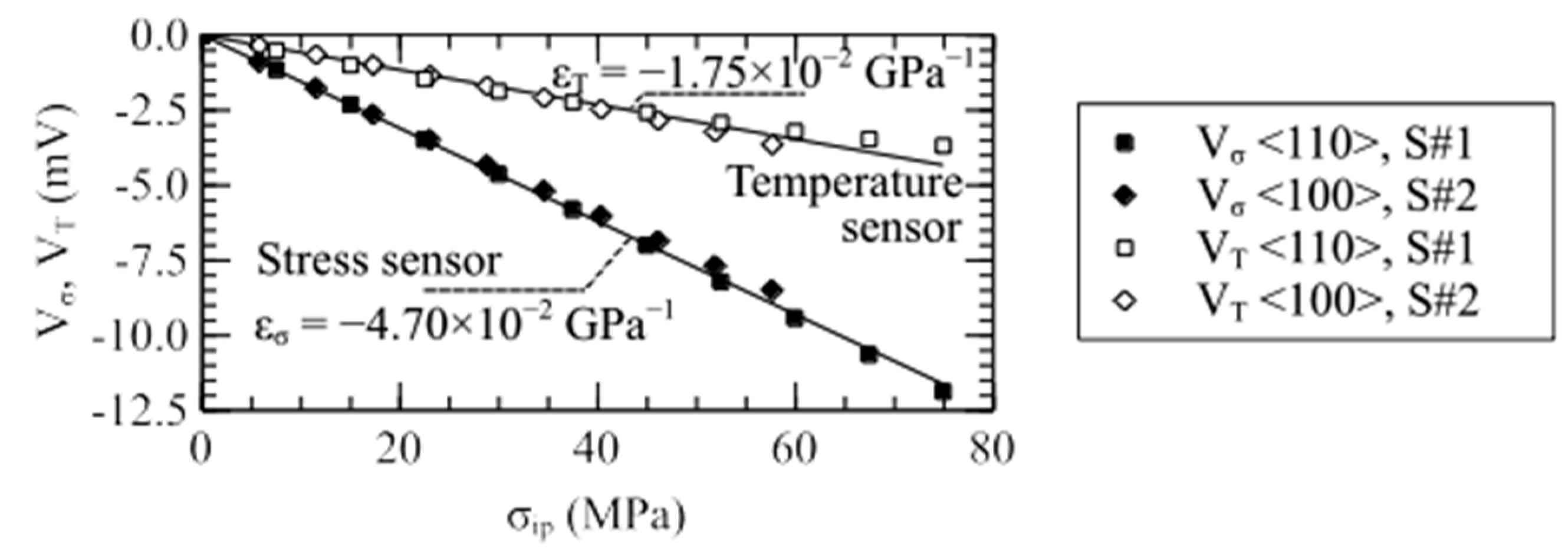A Combined Temperature and Stress Sensor in 0.18 μm CMOS Technology †
Abstract
:1. Introduction
2. Materials and Methods
2.1. Sensor Design and Implementation
2.2. Sensor Response
2.3. Extraction of Temperature and Mechanical Stress
2.4. Experimental Setup
3. Results
3.1. Stress Response
3.2. Thermal Response
3.3. Extraction of Temperature and Mechanical Stress, Residual Error
4. Discussion
Conflicts of Interest
References
- Huber, S.; Leten, W.; Ackermann, M.; Schott, C.; Paul, O. A Fully Integrated Analog Compensation for the Piezo-Hall Effect in a CMOS Single-Chip Hall Sensor Microsystem. IEEE Sens. J. 2015, 15, 2924–2933. [Google Scholar] [CrossRef]
- Souri, K.; Chae, Y.; Makinwa, K.A.A. A CMOS Temperature Sensor with a Voltage-Calibrated Inaccuracy of ±0.15 °C (3σ) from −55 °C to 125 °C. IEEE J. Solid State Circuits 2013, 48, 292–301. [Google Scholar] [CrossRef]
- Huber, S.; Schott, C.; Paul, O. Package Stress Monitor to Compensate for the Piezo-Hall Effect in CMOS Hall Sensors. IEEE Sens. J. 2013, 13, 2890–2898. [Google Scholar] [CrossRef]
- Haas, S.; Schramm, M.; Reuter, D.; Loebel, K.-U.; Horstmann, J.T.; Gessner, T. Direct integrated strain sensors for robust temperature behavior. In Proceedings of the TRANSDUCERS Conference, Anchorage, AK, USA, 21–25 June 2015; pp. 184–187. [Google Scholar]
- Huber, S.; Laville, A.; Schott, C.; Paul, O. A bridge-type resistive temperature sensor in CMOS technology with low stress sensitivity. In Proceedings of the IEEE Sensors Conference, Valencia, Spain, 2–5 November 2014; pp. 1455–1458. [Google Scholar]




© 2017 by the authors. Licensee MDPI, Basel, Switzerland. This article is an open access article distributed under the terms and conditions of the Creative Commons Attribution (CC BY) license (https://creativecommons.org/licenses/by/4.0/).
Share and Cite
Huber, S.; François, S.; Paul, O. A Combined Temperature and Stress Sensor in 0.18 μm CMOS Technology. Proceedings 2017, 1, 340. https://doi.org/10.3390/proceedings1040340
Huber S, François S, Paul O. A Combined Temperature and Stress Sensor in 0.18 μm CMOS Technology. Proceedings. 2017; 1(4):340. https://doi.org/10.3390/proceedings1040340
Chicago/Turabian StyleHuber, Samuel, Samuel François, and Oliver Paul. 2017. "A Combined Temperature and Stress Sensor in 0.18 μm CMOS Technology" Proceedings 1, no. 4: 340. https://doi.org/10.3390/proceedings1040340




